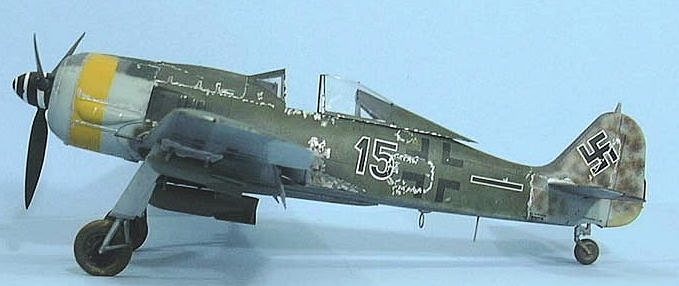
Hasegawa 1/32 FW-190F-8
| KIT #: | 08151 |
| PRICE: | 4800 yen |
| DECALS: | Three options |
| REVIEWER: | Tom Cleaver |
| NOTES: | Special edition with resin bombs |

| HISTORY |
The fighter-bomber versions of the
Fw-190A began with the Fw-190A-4/U4, which was modified to carry both a 250-lb
SC 500 bomb as well as two 66-gal drop tanks under the wings.
The Fw-190F was developed from this as a short-range
dedicated battlefield ground attack aircraft, while the Fw-190G was developed as
a long-range fighter bomber.
Limited numbers of Fw-190Fs were
created from early Fw-190A-4 and A-5 airframes, with the major production
version being the Fw-190F-8 developed from the Fw-190A-8. The Fw 190 F-8
appeared in March, 1944.
It differed from the Fw-190A-8 by being equipped with a
modified injector on the compressor which allowed for increased performance at
lower altitudes for several minutes. Additionally, the Fw-190F-8 was equipped
with the improved FuG 16 ZS radio unit, which allowed
much better
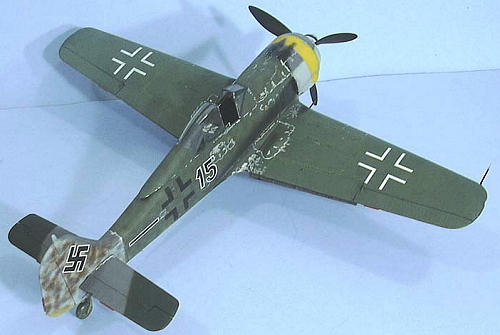 communication
with ground combat units.
communication
with ground combat units.
Armament of the Fw 190 F-8 was
restricted to two MG 151/20 20mm cannon in the wing roots and two MG 131 machine
guns mounted in the fuselage above the engine.
According to
official records, at least 3,400 F-8s were built, a greater number than the
Fw-190A-8, as of December 1944.
Several hundred more were likely produced between
February to May 1945, though the records are missing.
The Fw-190F-8 faced at least as
much ground opposition as did the P-47 Thunderbolt used as a fighter-bomber.
However, while the American fighter was produced in such
numbers that it was easy for a unit to write off a damaged airframe and obtain a
new replacement, the Luftwaffe was forced to rebuild damaged airframes in order
to maintain replacements.
The service was able to do this due to the high
standards of training for Luftwaffe mechanics and technical service personnel,
which was much more complete than that given their Allied counterparts, and gave
them the ability to do this sort of major depot work in the field when they had
the time.
This cannibalization of damaged airframes is shown in the many
photographs of Fw-190Fs where the camouflage of major subassemblies is different
enough to display the fact that the airplane photographed was rebuilt from
wrecks, often from more than one to get one serviceable airplane.
The prime user of the Fw-190F on
the Eastern Front was Schlachtgeschwader 2.
II/SG 2, formerly II/SchlG 1, converted to the Fw 190F beginning in late 1942,
while I/SG 2 kept on using older Bf-109Es and Ju-87s until they converted to the
new Fw-190F in June 1944. III/SG 2 continued to use the obsolete Ju 87D until
the end of the war.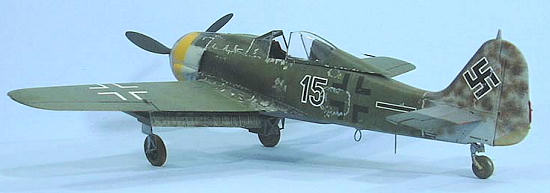
As one of only two FW-190 equipped
Schlachtgruppen on the Eastern Front,
II/SG 2 was heavily involved in the Crimean campaign during the first half of
1944.
While II/JG 52 was tasked with providing air cover, the Schlachtflieger
also flew numerous interception sorties and claiming 247 Soviet aircraft shot
down during the campaign. Leutnant
August Lambert claimed 70 kills during one 3 week period.
By May, 1944, the depleted II/SG 2
retired to Romania.
Following the Romanian surrender in late August, which
was followed by a declaration of war on Germany, the Luftwaffe units in the
country made a fighting withdrawal into Hungary in late September.
The winter campaign in Hungary and Slovakia was
hard-fought, with heavy losses on both sides.
The Fw-190Fs were always outnumbered by Soviet ground
attack aircraft, and their bases were constantly under attack.
By April, 1945, Slovakia had been
liberated and the Geschwader Stab and
II/SG 2 were based at Kummer, in northern Bohemia, with I/SG 2 in Austria, and
III/SG 2 outside Prague. With only limited fuel supplied and few aircraft, SG 2
continued supporting the retreat of Wehrmacht forces.
On 8 May 1945, facing capture by
the Soviets, Oberst Rudel,
Kommodore of SG2, decided to try to reach Western
Germany in order to surrender to the Western Allies. Rudel led the three Ju 87s
and four FW 190s still operational on a flight to the USAAF airfield at
Kitzingen. The rest of the unit formed a truck convoy which would travel west.
Befor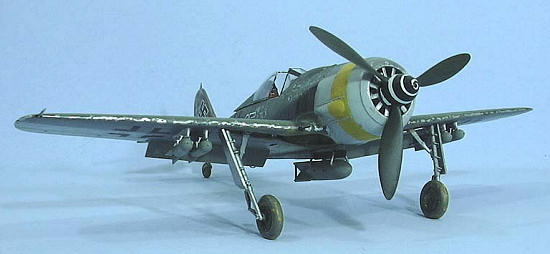 e
they could make their escape, the ground column was later attacked by Soviet
Stormoviks with the survivors then attacked a few hours later by roving American
fighter bombers. With all equipment destroyed, there were only a few survivors,
all of whom were captured by the Soviets.
e
they could make their escape, the ground column was later attacked by Soviet
Stormoviks with the survivors then attacked a few hours later by roving American
fighter bombers. With all equipment destroyed, there were only a few survivors,
all of whom were captured by the Soviets.
The leading ace of SG 2 was August Lambert, a former Stuka pilot who became a Luftwaffe fighter ace, Following his 70th victory in the Crimea, he was awarded the Knight's Cross of the Iron Cross. By April, 1945, Lambert’s score was 116, an indication of just how heavy the fighting was during the retreat on the southern front. On the morning of April 17, 1945, Lambert, Leutnant Gerhard Bauer, and another pilot were taking off from Kamenz on a ground attack mission when P-51Ds of the 55th Fighter Group appeared over the field. Bauer's FW 190 F-9 was quickly shot down north of Kuckau, 8 kilometers ESE of Kamenz. Lambert and his wingman tried desperately to get away, but could not lose their pursuers. Lambert was shot down just north of Hoyerswerda, 20 km NNE of Kamenz, and his airplane exploded on impact.
| THE KIT |
The Hasegawa Fw-190F-8 is a limited release. The plastic is the same as the Fw-190A-8, with the addition of plastic underwing bomb racks and four resin 100 Kg bombs and one SC 500 bomb.
| CONSTRUCTION |
Construction followed the usual
plan with Hasegawa Fw-190s.
I did notice that the underwing plug for this kit did
not fit as well as those on other kits I have built.
These plugs are the worst-designed part of the kits in
all releases, and always require the use of gap-filler, sanding smooth and
rescribing the surface detail.
I cut off the lower main gear
doors, as seen on many Fw-190s flown from primitive airfields on the Eastern
Front.
| COLORS & MARKINGS |
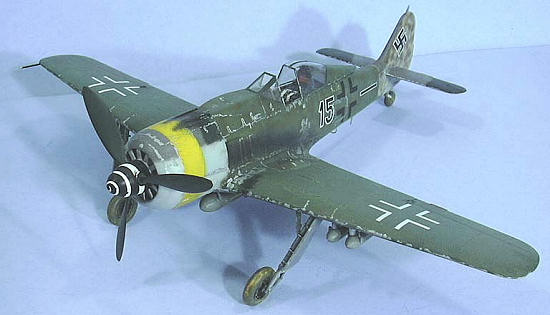 Painting:
Painting:
I had decided when I set out to
build this model that I wanted to recreate a Schlachtflieger with the “ridden
hard and hung up wet” look I found in several photographs of Fw-190F-8s seen on
German airfields at the end of the war.
I decided that my airplane would be a mix of engine,
central fuselage, rear fuselage and vertical fin, wing, and elevators, all from
different airplanes.
I also wanted to do the field-applied camouflage seen in
some photos.
I began by painting the model
overall in a standard factory camouflage of 75/82/76, the factory standard
adopted in late August 1944, with the “wraparound” on the wing of RLM75, with
the lower wing and the gear well left unpainted.
I then masked off the cowling and
the rear fuselage, and gave the central fuselage and the upper wing a “ragged”
coat of RLM83 Bright Green.
While not apparent in the photographs, there are several
“holidays” in this field-applied camo, through which one can discern the
original finish.
The central fuselage has blotches
of brown primer, which was also dappled over the rear fuselage and vertical fin.
The elevators were left in their original factory
finish, which included leaving the lower horizontal stabilizer unpainted, while
the 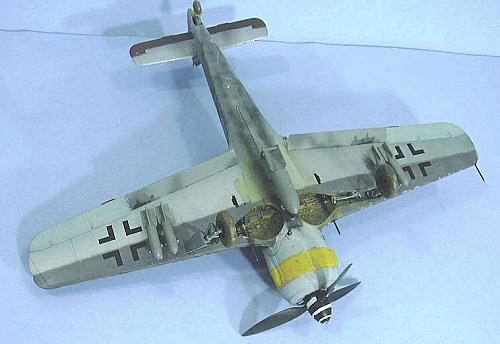 elevators
were repaired and finished with brown primer which was not over-painted in
camouflage paint.
elevators
were repaired and finished with brown primer which was not over-painted in
camouflage paint.
A yellow identification band was
painted around the cowling, in the manner used by SG 2.
Decals:
The decals were a combination of
kit decals and decals from the dungeon, to create “Black 15" of II/SG 2.
I had applied the stencils after I did the original
factory finish, so they could be overpainted in such a way that they showed
through the later camouflage application.
Final Finish:
I heavily weathered the model,
dinging it along all panels that would be opened for maintenance, applying mud
to the wheel wells, and heavy exhaust stains.
With all that done, I then applied
a coat of Xtracrylix Flat Varnish, with a dollop of Tamiya Flat Base, to get a
super-flat heavily weathered finish. I slipped the seat with Eduard seat belts
into position in the cockpit, and then attached the landing gear, prop and
canopy.
| CONCLUSIONS |
Well, this Fw-190F-8 definitely
marks the end of the line for my collection of big Hasegawa Butcher-birds
(unless they come out with an A-4).
I think this series of kits are among the best versions
of the Fw-190 done by anyone.
They’re so well designed and engineered that it’s
impossible for a modeler to make most of the mistakes that are so easy with all
the other kits - the misaligned landing gear, the wing misaligned, etc. - unless
the modeler works to make the mistake intentionally.
These kits go together easily, there is still a good
selection of aftermarket decals available, and the end result will look
impressive.
Any modeler with modest experience can be assured of producing a
nice-looking model from any of these kits.
Review kit courtesy of my wallet.
February 2009
If you would like your product reviewed fairly and quickly, please contact me or see other details in the Note to Contributors.